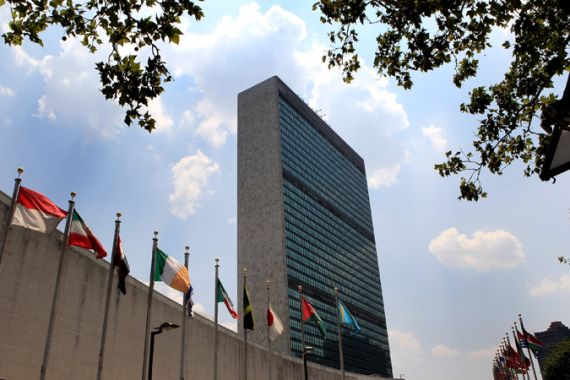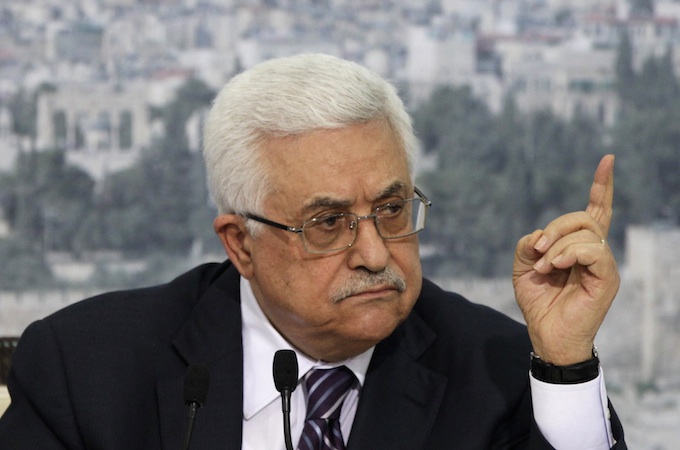What are the PLO’s options at the UN?
Abbas insists the PLO will only request full statehood, but Palestinians have many strategies available to them at UN.

 |
| Despite diplomatic pressure, Mahmoud Abbas plans to push for full statehood at the UN [Reuters] |
The Palestinian Liberation Organisation (PLO) will go before the United Nations on Friday to apply for full statehood at the international body.
Husam Zomlot, a deputy of Fatah’s Department of Foreign Relations, who is representing the PLO in New York, said: “We will go the fastest route”. Yet it is uncertain what the fastest route is, or what strategy the PLO will use.
Mahmoud Abbas, the president of the Palestinian Authority, insisted in a televised speech on September 16 that the PLO will bring its case before the Security Council.
But in a last-ditch attempt, US and European diplomats are trying to convince the PLO delegation in New York to withdraw their bid and return to the negotiating table.
Meanwhile, some Arab leaders have told Abbas to request non-member observer status at the General Assembly instead.
The following are options the PLO team in New York may be considering:
Strategy 1: Go before the Security Council for full UN membership
At the moment, this strategy seems most likely. As mentioned above, Abbas has forcefully proclaimed the PLO’s desire to press for full statehood.
If the PLO does indeed decide to go before the Security Council it must clear several hurdles.
To become a state, at least nine of the 15 members of the Security Council will have to vote for the resolution, with none of the council’s five permanent members vetoing it.
|
“Failure at the Security Council may itself be a drawn-out process.“ – Analyst and former advisor Daniel Levy |
If this were to pass in the Security Council, then according to Article 4(2) of the UN Charter, the Council would recommend Palestine for UN membership at the General Assembly.
Two-thirds of the General Assembly, or 129 countries, must then vote in favour of statehood.
Some experts believe that the Security Council route may buy diplomats time to convince Palestinians to return to negotiations.
The process will take longer, because it will involve applications, committee meetings and deliberations.
Daniel Levy, an analyst and former advisor to Israeli cabinet ministers, said that “failure at the Security Council may itself be a drawn-out process.
“Any application would almost certainly have to be considered by a technical committee of the whole, and that could take time.”
Levy also argued that if they went before the Security Council, “the Palestinians would then deny themselves the option of going for a win at the General Assembly”.
Going to the Security Council instead of the General Assembly has been considered a more confrontational approach because it could isolate the US and signal a new phase in US-Palestinian relations.
Daniel Rubinstein, the US consul general in Jerusalem, has said that the US would cut aid to the Palestinian Authority if the PLO presses forward with its UN bid for statehood.
Human rights lawyer Noura Erakat told Al Jazeera: “The act [of applying for statehood] would basically be saying ‘we are now severing our diplomatic relations with the US and trying something different’.”
Will this approach succeed?
As of now, the Obama administration has vowed to veto a Security Council recommendation for Palestinian statehood.
Without this recommendation, the General Assembly is not empowered to admit Palestine as a full UN member state.
However, a veto by a permanent UN Security Council member, such as the US, can be overcome through the “Uniting for Peace” resolution, otherwise known as Resolution 337, which was passed in November 1950.
The resolution was approved in response to the USSR’s veto of proposed Security Council measures to protect South Korea from North Korean aggression.
The resolution permitted collective action in order to maintain international peace and security if the Security Council is unable to vote due to a veto.
In the wake of the Suez Crisis in 1956, Resolution 337 was invoked to establish a UN force to “secure and supervise the cessation of hostilities”.
The UK and France voted against a similar measure, but Resolution 337 provided a way around their opposition by enabling the General Assembly to form a UN force instead.
If the case is made that obstructing Palestine’s statehood would threaten international security, the General Assembly could invoke Resolution 337 if two-thirds of the Assembly vote to do so.
Then, the General Assembly would have to vote again – also by a two-thirds majority – to accept Palestine as a full member state.
Strategy 2: Go to the General Assembly to gain the status of a ‘non-member observer state’ at the UN
Another possible, but less likely, path the PLO could take would be to apply for “non-member observer state” at the UN.
In 1974, the General Assembly passed Resolution 3237, which granted the PLO observer status at the UN.
Since 1988, the UN has categorised Palestine under the heading “Entities Having Received a Standing Invitation to Participate as Observers in the Sessions and the Work of the General Assembly and Maintaining Permanent Observer Missions at Headquarters”.
This approach would mean requesting the General Assembly replace the word “Entity” with “State” in the categorisation above.
Palestine would therefore be on a list of observer states. At the moment, the Holy See is the only observer state at the UN.
This upgrading from “Entity” to “State” would allow the Palestinians to join several international organisations and sign onto human rights treaties.
The power of the upgrade would be dependent on the exact text of any such resolution.
Levy thinks that winning such a General Assembly vote would “give them [the Palestinians] a little more recourse in international organisations” and would improve their leverage vis-a-vis Israel.
Will this approach succeed?
The advantage of this strategy is that it would require only a simple majority of the 193-nation General Assembly.
Abbas said on September 16 that more than 126 states already recognise the state of Palestine, meaning that the PLO could probably win such a vote easily.
Erakat thinks that this path would be more likely to succeed than the first strategy.
“I have heard rumblings that there is a strong preference to go to the General Assembly rather than the Security Council,” she said.
“I am 110 per cent convinced that the current Palestinian leadership is not prepared to do that [go to the Security Council].”
|
“In political terms we have [already] won half of the exercise.“ – PLO representative Husam Zomlot |
Strategy 3: Request the General Assembly to adopt a resolution ‘recommending’ the recognition of Palestinian statehood based on 1967 borders
The UN routinely passes resolutions expressing its recommendations on a wide variety of subjects.
For example, the UN has already passed several Palestine-related resolutions on Palestinians’ right to self-determination, their right of return, and for changes to Israel’s settlement policies.
Thus this option would not significantly advance Palestine on the path to statehood; however, it would help to further highlight the Palestinian cause.
Husam Zomlot, a senior official representing the PLO in New York, said: “In political terms we have [already] won half of the exercise.
“We have reinforced forcefully on the international agenda the need for a Palestinian state.”
Strategy 4: Withdraw bid for UN statehood
Finally, the PLO could decide to withdraw its bid.
This is unlikely to happen, but could take place if the US, Israel or certain European countries can convince the PLO at the last minute to pull back from any UN effort.
“Our approach is to get the sides back to the negotiating table,” Mark Toner, a US State Department spokesman, said on Thursday.
“As I said, we’re engaged very intensively on the ground.”